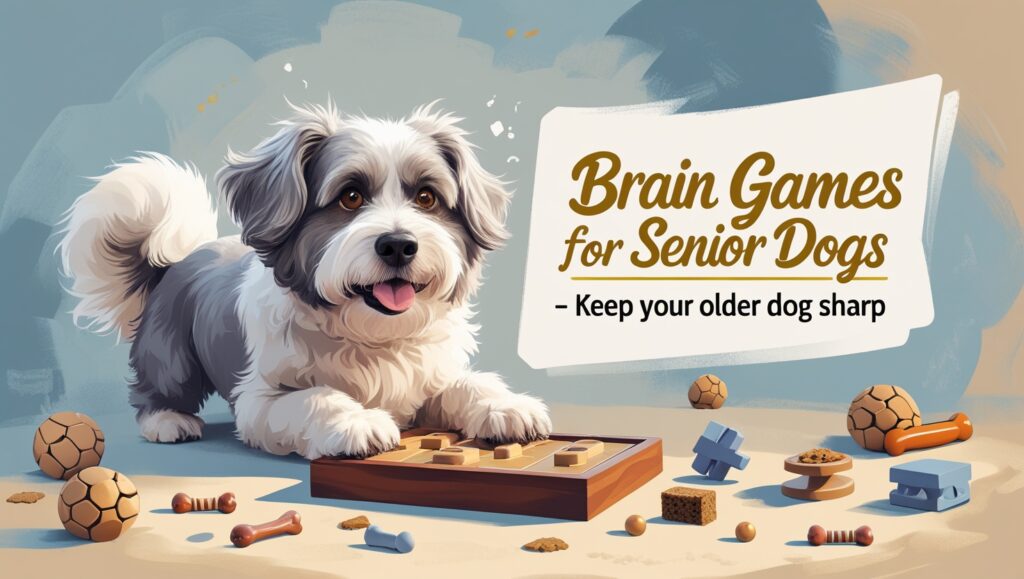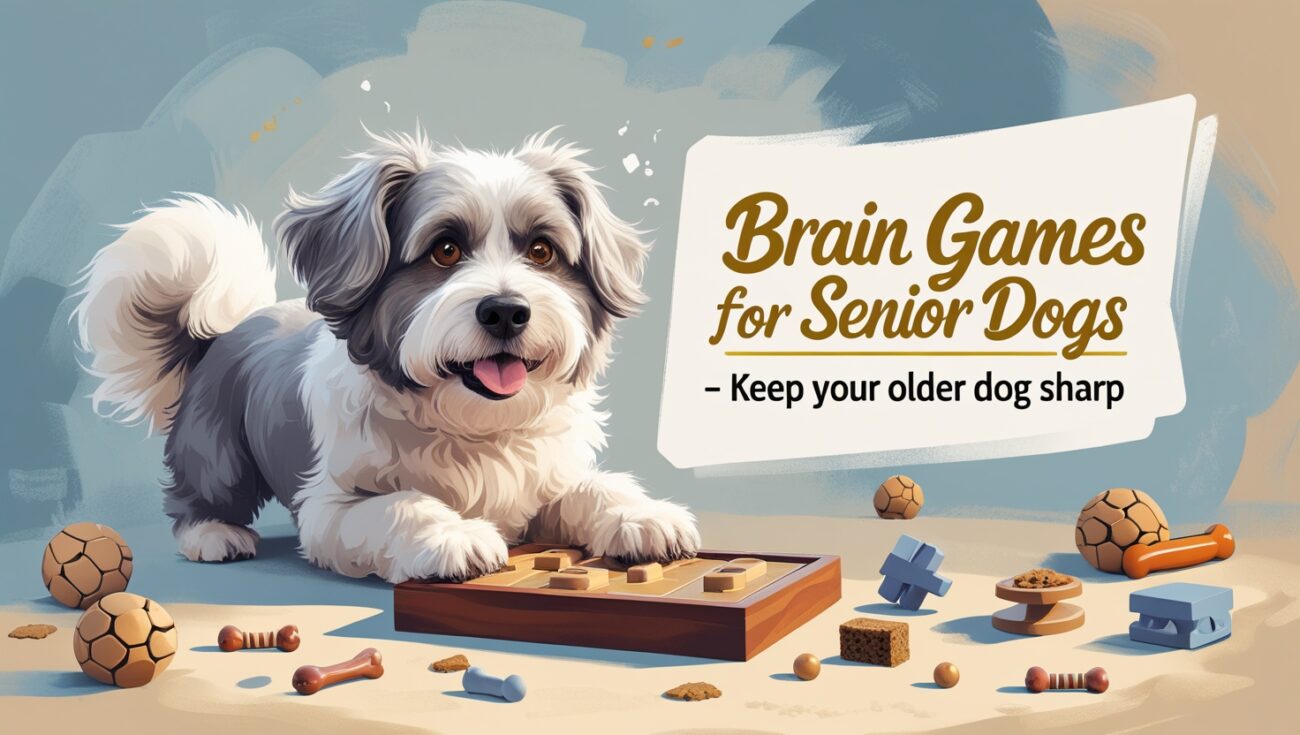Brain Games for Senior Dogs — Keep Your Older Dog Sharp
As my dog started to get older, I noticed little changes — a bit slower on walks, more naps during the day, and sometimes she seemed just a little bored. That’s when I realized that mental stimulation is just as important for senior dogs as physical exercise. In fact, using brain games can help keep your older dog sharp, happy, and engaged well into their senior years.
In this post, I’ll share my favorite brain games for senior dogs — the ones that helped my girl stay mentally active and more connected with me. And if you want a full step-by-step system (this is what I use), here’s my personal link:
Brain Training for Dogs — Click here to learn more

Table of Contents
Why Senior Dogs Need Brain Games
Just like humans, dogs experience some cognitive changes as they age. Keeping their mind active with daily brain stimulation helps prevent decline and keeps their behavior more balanced.
I noticed that after adding brain games to our routine, my dog was:
- More alert
- More interactive
- Less anxious
- More responsive to cues
- Happier overall
Plus, it’s a great way to spend quality time with your older dog.
5 Great Brain Games for Senior Dogs
1. Scent Games
Scent work is perfect for older dogs because it doesn’t require fast movement — just their natural sniffing ability. I hide treats in the house and let my dog sniff them out. It’s fun, calming, and mentally stimulating.
2. Puzzle Feeders
Feeding with puzzle toys helps your dog use problem-solving skills at mealtime. Even my older dog still loves working out how to get the food out — it keeps her sharp and slows her eating too.
3. Slow, Positive Trick Training
Even old dogs can learn new tricks! We keep it simple — things like “paw,” “spin,” or “touch.” These sessions keep my dog engaged and focused.
If you want a great list of senior-friendly tricks, this is the program I follow:
Brain Training for Dogs — Full Program Here
4. Muffin Tin Game
I put treats in a muffin tin, cover them with tennis balls, and let my dog figure out how to move the balls. It’s a low-impact, fun activity that makes her think.
5. “Find It” Games
I’ll hide a favorite toy or treat under a towel or in a small pile of blankets and encourage my dog to search for it. It keeps her curiosity going and gives her a sense of accomplishment.
Final Thoughts
Adding brain games to my older dog’s routine helped her stay sharp, happy, and mentally active — even as her physical pace slowed a little.
If you want an easy, step-by-step system that works for senior dogs, this is the one I trust and use:
Brain Training for Dogs — Click here to check it out
Trust me — your older dog will love it, and you’ll love seeing them stay bright and connected.
Before I started using brain games with my older dog, I thought slowing down was just part of aging. But I quickly learned that with the right mental stimulation, senior dogs can stay sharp and engaged well into their later years.
What really surprised me was how quickly my dog’s alertness improved after adding brain games. Within just a couple of weeks, she was more interactive, more playful, and more responsive — even on days when we didn’t go for long walks.
Many senior dogs experience boredom or mild cognitive decline simply because they aren’t getting enough mental enrichment. The good news? It doesn’t take much to turn things around — just a few minutes a day of the right games.
I also noticed that these activities helped reduce anxiety in my older dog. She was less prone to pacing, whining, or barking at random sounds after doing brain work regularly.
If you’re not sure how to start, or which games are safe and fun for older dogs, this is the exact program I follow:
Brain Training for Dogs — Full Program Here
It’s packed with ideas that work great for senior dogs, even if they have limited mobility.
Another great benefit? These games strengthen your bond with your dog. Older dogs sometimes feel left out when their younger years of active play are behind them — but brain games give you a new way to connect and enjoy time together.
And because mental stimulation tires them out, I found that my dog started sleeping more soundly at night — which is a huge win for both of us.
Even if your dog has some physical limitations, there are plenty of ways to keep them engaged. Scent games, puzzle toys, and simple problem-solving activities work beautifully.
One thing I love about this program is that it helps you adapt the games for your dog’s ability level:
Brain Training for Dogs — Click here to check it out
That means you can keep your dog mentally stimulated — whether they’re still active or prefer gentler games.
If your older dog seems bored or disconnected lately, don’t wait. Adding daily brain games can dramatically improve their quality of life — I’ve seen it firsthand.
And honestly? Seeing the spark in your senior dog’s eyes when they figure out a new puzzle or enjoy a simple game is one of the best feelings.
If you want an easy way to start, this program makes it simple:
Brain Training for Dogs — Full Program Here
Give it a try — your older dog will thank you for it.
One thing I wish I had done sooner was start using brain games before my dog hit her senior years. But even starting later made such a difference — proving that it’s never too late to help your dog stay sharp.
What’s great is that these games don’t need to be complicated or time-consuming. Even short sessions — 10 to 15 minutes — give your older dog’s mind a healthy workout.
I also found that brain games helped reduce separation anxiety in my older dog. The mental stimulation helped her relax when I left the house, making goodbyes much easier for both of us.
If you want a proven, ready-to-use plan for adding these games, this is exactly what I used:
Brain Training for Dogs — Click here to get started
The beauty of this program is that it works for dogs of all ages, so it’s easy to adapt for your older pup’s energy level and abilities.
Another big bonus? These games can help reduce cognitive decline. Just like humans need mental stimulation to stay sharp, so do dogs — and the right activities can help slow age-related changes.
Since adding daily brain training, I’ve noticed my dog stays more engaged with the family — she seeks out interaction instead of napping the day away.
If you want to give your older dog the best quality of life, start using brain games now. You’ll love the results — and your dog will too.
Brain Training for Dogs — Full Program Here

